
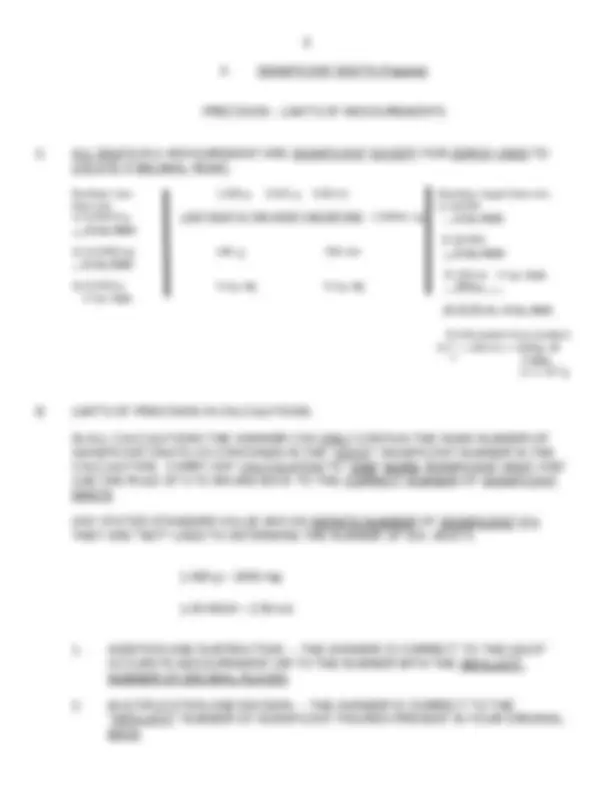
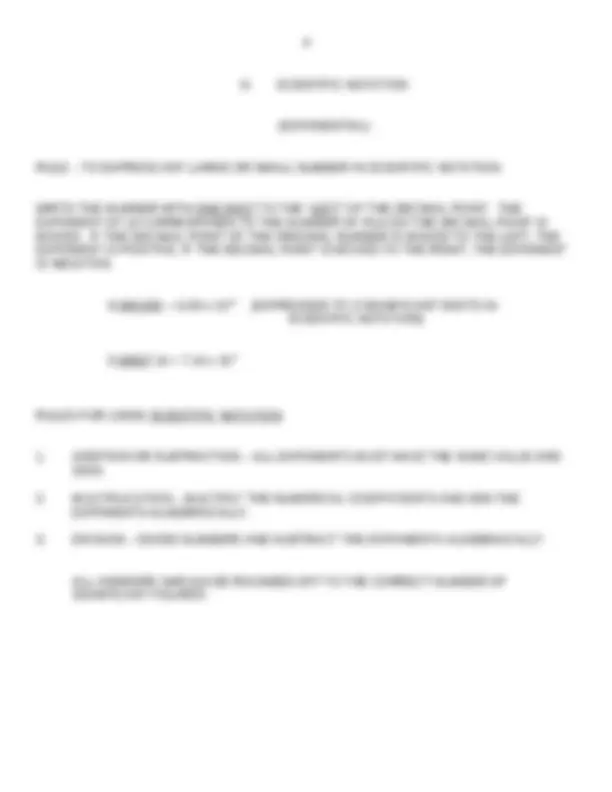
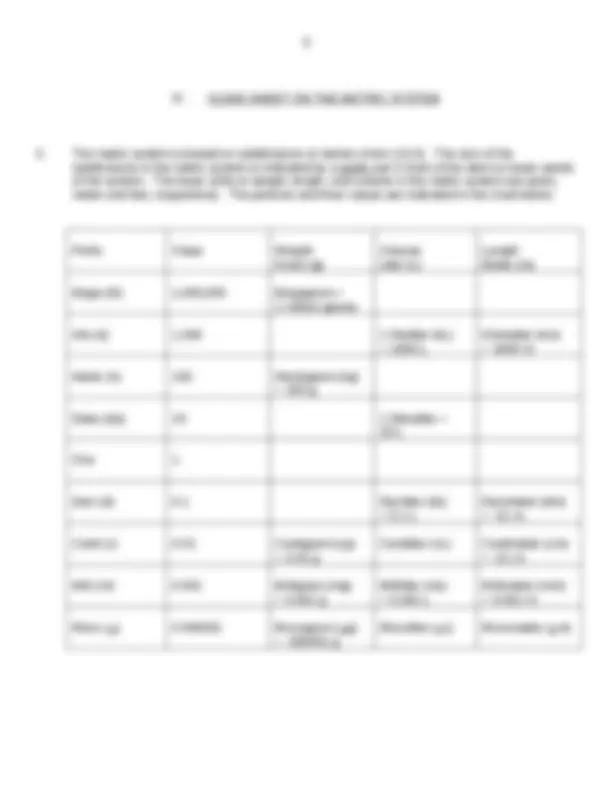
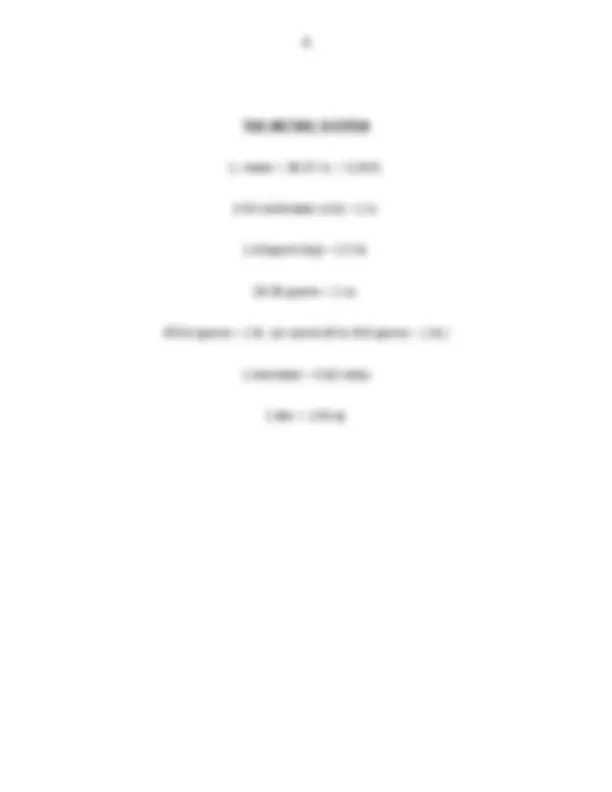
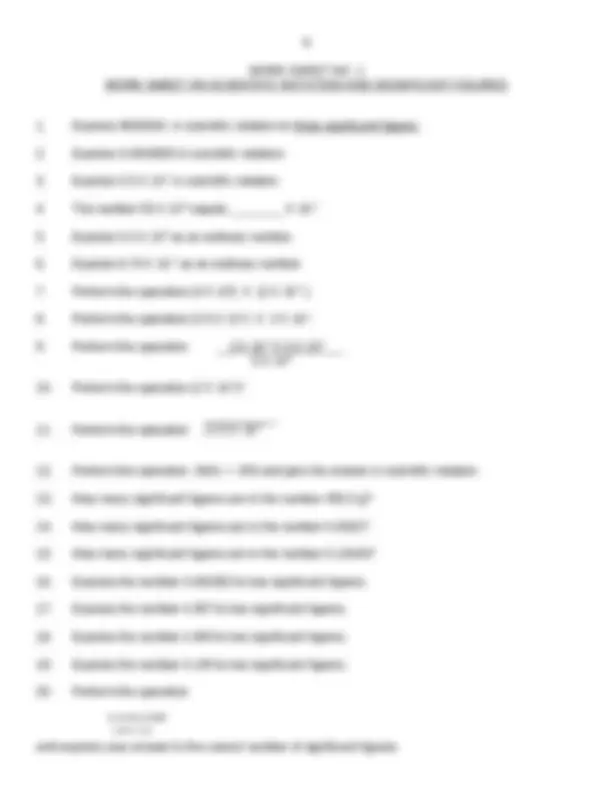
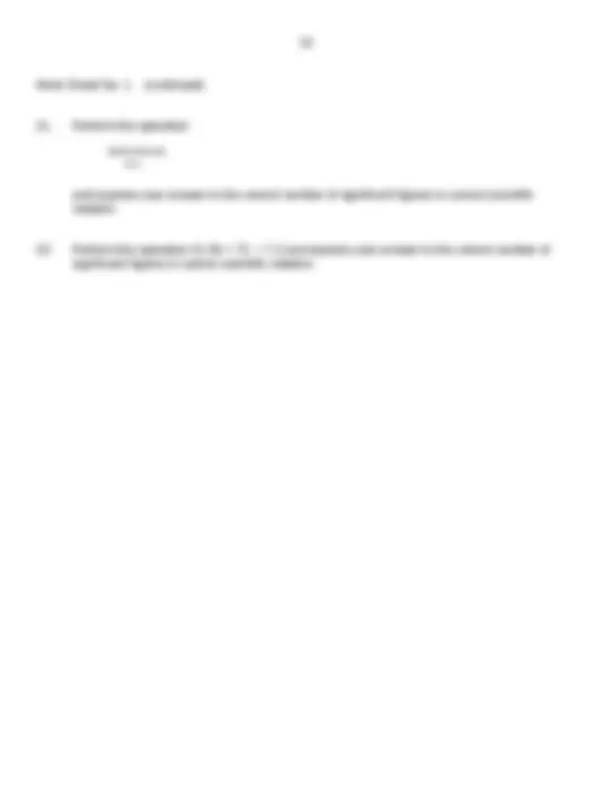
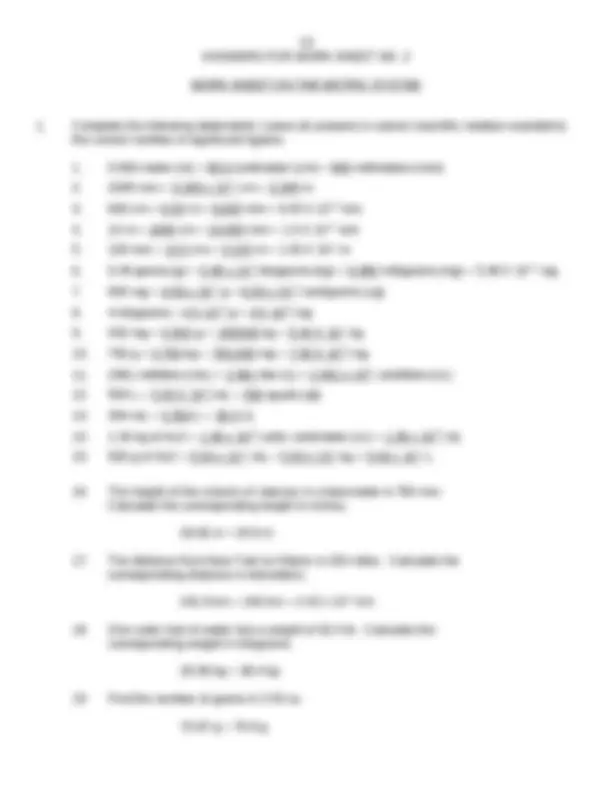

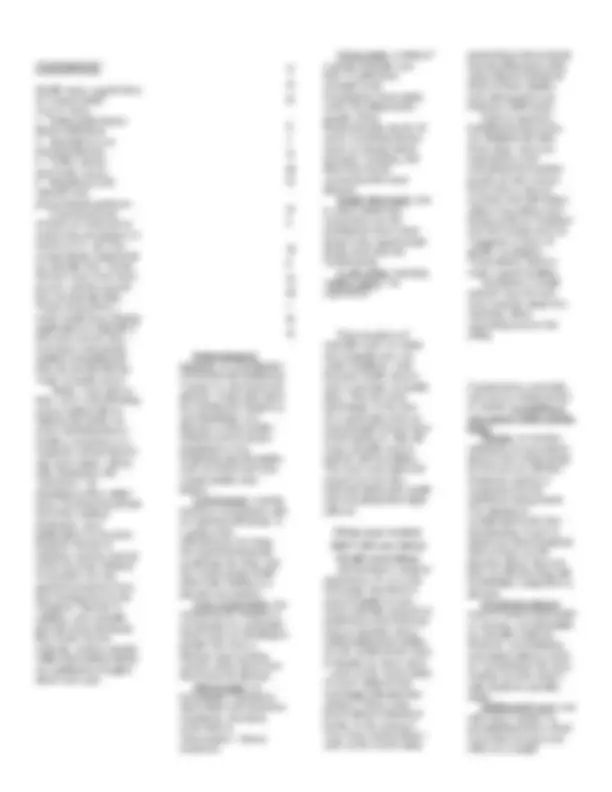


Study with the several resources on Docsity

Earn points by helping other students or get them with a premium plan


Prepare for your exams
Study with the several resources on Docsity

Earn points to download
Earn points by helping other students or get them with a premium plan
Community
Ask the community for help and clear up your study doubts
Discover the best universities in your country according to Docsity users
Free resources
Download our free guides on studying techniques, anxiety management strategies, and thesis advice from Docsity tutors
Material Type: Notes; Professor: Santiago; Class: General Chemistry I (GL); Subject: Chemistry; University: Harford Community College; Term: Unknown 1989;
Typology: Study notes
1 / 17

This page cannot be seen from the preview
Don't miss anything!










LECTURE NOTES and OBJECTIVES Scientific Method – Significant Digits Scientific Notation – The Metric System
You should be able to do the following:
6.000,000. = 6.00 x 10+6^ [EXPRESSED TO 3 SIGNIFICANT DIGITS IN SCIENTIFIC NOTATION]
A. The metric system is based on subdivisions or factors of ten (10.0). The size of the subdivisions in the metric system is indicated by a prefix put in front of the stem or basic words of the system. The basic units of weight, length, and volume in the metric system are gram, meter and liter, respectively. The prefixes and their values are indicated in the chart below. Prefix Value Weight Gram (g) Volume Liter (L) Length Meter (m) Mega (M) 1,000,000 Megagram = 1 million grams Kilo (k) 1,000 1 Kiloliter (kL) = 1000 L Kilometer (km) = 1000 m Hecto (h) 100 Hectogram (hg) = 100 g Deka (da) 10 1 Dekaliter = 10 L One 1 Deci (d) 0.1 Deciliter (dL) = 0.1 L Decimeter (dm) = .01 m Centi (c) 0.01 Centigram (cg) = 0.01 g Centiliter (cL) Centimeter (cm) = .01 m Milli (m) 0.001 Milligram (mg) = 0.001 g Milliliter (mL) = 0.001 L Millimeter (mm) = 0.001 m Micro () 0.000001 Microgram (g) = .000001 g Microliter (L) Micrometer (m)
Example No. 2 Change 100 milligrams (mg) to grams. There are therefore 100 mg X ___1 g____^ = 100g^ = 0.100 g answer = 1.00 = 1.00 X 10-1^ g 1000 mg 1000 Example No. 2a - - Problem No. 1 on worksheet 0.900 m = __________________ cm (100 cm = 1m) 0.900 m X 100 cm^ = 90.0 cm = 9.00 X 10+1^ cm 1 m 90.0 cm = _____________ mm (10 mm = 1 cm) Example No. 3 - - Problem 6 5.49 g = ________________ kg (1000 g = 1 kg) Example No. 4 - - Problem No. 11 2361 mL = _________________ L 1000 mg = 1 g
Work Sheet No. 1 (continued)
and express your answer to the correct number of significant figures in correct scientific notation.
relationship—for example, we say “the sleet storm caused him to run off the road.” But disease (like many other events in nature) results from the interaction of many factors. Indeed, even running off a road in a storm is “multifactorial.” Otherwise everyone driving in the storm would skid off the road. Statistically significant result: an association between two factors that is greater than would occur at random. Traditionally, statistical significance is determined by a mathematical formula: there must be less than a 1-in-20 chance that a cause-and-effect relationship apparently demonstrated in an experiment is caused by chance alone. The slippery verbal slope “May”: does not mean “will.” “In some people”: does not mean “in all people.” “Indicates” or “suggests”: does not mean “proves.” “Contributes to,” “is linked to,” or “is associated with”: does not mean “causes. “Proves”: scientific studies gather evidence in a systematic way, but one study, taken alone, seldom proves anything. “Breakthrough”: a breakthrough happens now and then-for example, the discovery of penicillin or the polio vaccine. But today the word is so overworked as to be meaningless. “Doubles the risk” or “triples the risk”: may or may not be meaningful. Do you know what the risk was in the first place? If the risk was 1 in a million, and you double it, that’s still only 1 in 500,000. If the risk was 1 in 100 and increases by 25%, that’s 1 in 75, which may be cause for concern. Organizations (such as the American Heart Association or the American Cancer Society) issue press releases, and so do medical schools, drug companies, hospitals, and food manufacturers. Some releases accurately and helpfully represent the scientific work. Some— deliberately or unconsciously— manipulate the facts and overstate the case. But they seldom present enough detail to allow a critical analysis of the study and provide a basis for careful reporting. Enterprising researchers, institutions, and corporations have been known to hire public relations experts to promote their work and help them land on the front page or evening news. People tend to believe what they want to believe. Even when good research is meticulously reported, readers (and advertisers) tend to draw their own conclusions. How studies go wrong Broadly speaking, a study is any research investigation. The foundation of science is empirical, objective evidence, which can be gathered only through experimentation and observation. One test of a study’s validity is that anybody, anywhere should be able to conduct the same experiment and achieve the same results. But the import of a study is not always immediately clear, and the possibilities for error are many. For example, in a well- publicized study some years ago, people who were admitted to a coronary care unit because of a heart attack were found to have drunk significantly more coffee than people admitted to other units of the hospital. This shows that coffee drinking causes heart attacks, right? You might think so, until you consider that people admitted to the hospital for other reasons than a heart attack often had chronic illnesses that had led them to cut coffee consumption on their own. The error here is known as “selection bias.” The comparison group (or “control”) wasn’t appropriately chosen. Also, what about the people who died of a heart attack on the way to the hospital? Did they drink coffee or not? Then there’s the problem of what’s called “statistical power”- The probability of finding something, if in fact it’s really there. The size of the sample (the number of cases or subjects in a study) is one determinant of statistical power. If a study looks at only six patients; for example, and a certain drug proves effective in half of them, you still can’t predict that the same drug would be effective in half a larger population. But large studies are very costly. The duration of a study may also affect statistical power. In one large Finnish study of heart disease, for instance, subjects who lowered their cholesterol intake and made other life-style changes did not have a significantly lower death rate than a control group during the first six to eight years. But after ten years, significant benefits began to show up. This doesn’t mean that no study is ever clear, or that all scientific work should be regarded with distrust. It simply underlines the fact that it’s usually unwise to generalize from a single study, and that scientific progress is usually show and steady, rather than a matter of dramatic “breakthroughs.” The art of self- defense Don’t jump to conclusions. Changing your daily habits on the basis of a single study is almost never a good idea. Keep your skepticism in working order. Science is an uncertain undertaking. Progress is measured less often by dramatic insights than by the slow accumulation of knowledge. “Astounding” medical advances are rare. Don’t be too quick to believe in miracles. “Medical milestone” in a press report is like the work “natural” on a food package: something to arouse rather than allay your suspicions. Notice where the information is coming from. Does the author of the article cite any authorities? Does she appear to rely on scientific evidence – or simply relate a lot of anecdotes? Look out for warning signals such as “thousands of people say…” or “it’s well known that…” Is any source given for astounding statistics? Even attributed statistics can be wrong, of course, but it’s usually a good sign if the author cites reputable sources. Use logic and common sense. If the article says that the Japanese are healthier than Americans and claims it’s because the Japanese eat more
fish, stop and think, they also eat a lot of rice. They sleep on mats instead of mattresses. How does the writer know it’s the fish that does the trick? The heart attack rate tends to be higher in countries where most households have telephones, but that doesn’t mean phones cause heart attacks. Try to distinguish between promising advances that are reported as scientific news and public health recommendations. If doctors at a medical center have just done the first successful liver transplant, that’s interesting. But it doesn’t mean there’s now a cure for liver disease. On the other hand, if the Surgeon General or the American Cancer Society says “eat less fat” or “don’t smoke,” you can safely assume that many studies support this advice. Be wary when studies are cited to sell a product. Manufacturers and industry groups have been known to embroider the truth. Wellness Letter, September 1990